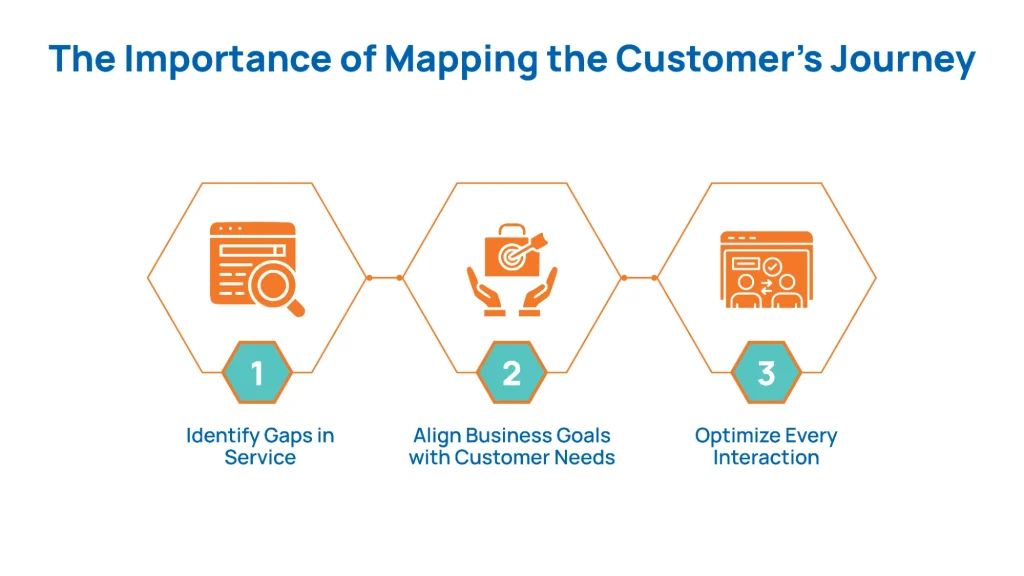- 73% of customers say experience is essential in purchasing decisions, but only 49% feel that companies deliver a good experience.
- One-third of consumers will leave a brand they love after just one bad experience.
In this blog, you will learn:
|
What is a Customer Journey Map?
A customer journey map visually represents how customers interact with your brand at different stages of their experience. It outlines the essential touchpoints, emotions, and potential challenges customers face as they move from awareness to purchase and beyond. This helps you see your business from the customer’s perspective, enabling you to improve engagement and address any pain points. The main goal of a customer journey map is to help you understand your customers better. By breaking down each step of their journey, you can identify what works well and what needs improvement. Here’s how it helps:The Importance of Mapping the Customer’s Journey
 It’s easy to assume that your business delivers a great experience, but the real question is—does your customer feel the same way? Mapping the journey from their point of view helps you:
It’s easy to assume that your business delivers a great experience, but the real question is—does your customer feel the same way? Mapping the journey from their point of view helps you:
-
Identify Gaps in Service
-
Align Business Goals with Customer Needs
-
Optimize Every Interaction
Essential Components of a Customer Journey Map
A well-structured customer journey map helps you understand how customers interact with your brand, their challenges, and how you can improve their experience.-
Buyer Persona
| Demographics | Age, gender, location, income, occupation, etc. |
| Behavior | Shopping habits, preferences, online activity, brand interactions. |
| Needs & Pain Points | What problems are they trying to solve, and what factors influence their decisions? |
-
Customer Stages
| Type | Description |
| Awareness | The customer realizes their need or problem and seeks a solution. |
| Consideration | They compare options, read reviews, and gather information before deciding. |
| Purchase | The customer makes a transaction, whether online or in-store. |
| Retention | After the purchase, they engage with your brand through customer support, product use, or loyalty programs. |
| Advocacy | A satisfied customer may leave a review, recommend your brand, or become a repeat buyer. |
-
Touchpoints
- Digital Touchpoints: Website visits, mobile app interactions, email marketing, social media engagement.
- Physical Touchpoints: In-store experiences, customer service calls, product packaging.
- Third-Party Touchpoints: Online reviews, word-of-mouth recommendations, and social media discussions.
-
Pain Points & Friction Areas
-
Emotions & Motivations
-
Opportunities for Improvement
5 Best Customer Journey Map Examples
Here are five real-world examples of businesses that effectively use customer journey mapping to enhance their services and reach the right audience.1. Spotify – Enhancing the Music-Sharing Experience
Spotify wanted to improve the music-sharing feature by making it easier for users to discover, share, and interact with music. Here is what Spotify focused on:- User Actions – From opening the app to engaging with a shared song.
- Touchpoints – Social media, in-app sharing, and notifications.
- Pain Points – Users found sharing and engaging with music unclear or complicated.
2. Amazon – Optimizing the Online Shopping Experience
Amazon aimed to create a hassle-free shopping experience that encouraged repeat purchases and customer loyalty. Amazon focused on:- Customer Touchpoints – Website, mobile app, email notifications, and customer service.
- Pain Points – Complicated checkout process, unclear delivery tracking, and difficulty finding relevant products.
- Emotions – Customers wanted speed, convenience, and reliability when shopping online.
3. Airbnb – Simplifying the Booking Process for Travelers
Airbnb wanted to make finding and booking accommodations easier while helping hosts connect with the right audience. They focused on:- Traveler Journey Stages – Searching for a stay → Comparing options → Booking → Staying → Leaving a review.
- Pain Points – Trust issues, unclear pricing, and difficulty navigating listings.
- Touchpoints – Website, app, emails, customer service, and host interactions.
4. Starbucks – Elevating the Loyalty Program Experience
Starbucks wanted to improve its customer loyalty program to encourage repeat purchases. What they focused on:- User Touchpoints – Starbucks app, in-store purchases, emails, and social media.
- Pain Points – Users found it difficult to track and redeem rewards.
- Emotions – Customers wanted a simple, rewarding, and engaging experience.
5. Uber – Improving the Ride-Booking Experience
Uber wanted to enhance the user experience from booking a ride to reaching the destination by eliminating friction and improving convenience. They focused on:- Clearly Defined Stages – Searching for a ride → Booking → Ride experience → Payment → Review.
- Touchpoints – Uber app, notifications, driver communication, payment processing.
- Pain Points & Emotions – Customers experienced frustration with ride availability, fare changes, and payment issues.
How to Create a Customer Journey Map that Works?
 To ensure your map is practical, here are the essential elements to focus on:
To ensure your map is practical, here are the essential elements to focus on:
1. Base It on Research and Real Customer Data
A compelling journey map should be built on real insights, not just assumptions. This means using a mix of market research and understanding broader trends, industry benchmarks, and competitor strategies and collecting insights through surveys, reviews, and direct interactions. This combination ensures you capture both customer expectations and real-world experiences. Since customers don’t always know what they need, analyzing their behaviors and continuously refine your offerings based on data.2. Cover More Than Just the Marketing Funnel
Many businesses focus only on marketing when mapping the customer journey. While marketing plays a role, a complete journey map should include: Pre-Purchase Stages – How customers discover and research your product. Purchase Process – The buying experience, ease of checkout, and transaction process. Post-Purchase Interaction – Customer support, product usage, retention, and loyalty. A journey map should track customers' actions, thinking, and feelings at each stage. It should also highlight interactions beyond marketing, such as customer service and product engagement, to ensure a seamless experience.3. Include Measurable Performance Indicators
Adding key performance indicators (KPIs) allows businesses to measure success and identify areas for improvement. Some essential KPIs include:- Customer Satisfaction Scores (CSAT) – Measures overall satisfaction at different touchpoints. For example, After a customer interacts with a live chat support agent, they receive a survey asking, "How satisfied were you with this support experience?"If 85% of responses rate 4 or 5 stars, the CSAT score indicates high customer satisfaction.
- Net Promoter Score (NPS)—This indicator identifies how likely customers are to recommend your brand. For example, an e-commerce company sends an email survey to recent buyers asking, "On a scale of 0 to 10, how likely are you to recommend us to a friend?" If most customers rate 9 or 10, the company has a high NPS, indicating strong brand advocacy.
- Conversion Rates—This Track how well potential customers move through the journey. For example, a SaaS company tracks the percentage of users who sign up for a free trial and later convert to a paid plan. If 20 out of 100 trial users upgrade, the conversion rate is 20%, highlighting the effectiveness of the onboarding process.
- Customer Retention Rate – Evaluate how many customers return after their first purchase. For example, a subscription box service analyzes how many customers renew their subscription for a second month. If 70% of first-time subscribers continue for another cycle, the retention rate is 70%, indicating customer loyalty.
- Support Metrics – Response time, resolution speed, and common customer issues. A telecom company measures the average time it takes for customer support to respond to inquiries. If their live chat has an average first-response time of 30 seconds and an issue resolution time of 5 minutes, it signals efficient support operations.
4. Keep It Dynamic and Up-to-Date
A customer journey map is not a one-time project—it should evolve as customer behavior and business goals change. Regular updates ensure that your strategy stays relevant. Some factors to monitor and adjust include new customer behaviors or preferences and changes in how customers interact with your product or service. Businesses should regularly refine their journey maps using analytics tools and customer feedback to improve the customer experience.5. Utilize CCaaS Solutions for a Better Customer Journey
Contact Center as a Service (CCaaS) solutions improve the customer journey by centralizing and streamlining interactions. These platforms integrate multiple communication channels—voice, email, chat, and social media—into a single system, ensuring customers receive fast, relevant, and consistent support at every stage. Essential CCaaS Features That Enhance the Customer Journey:- Omnichannel Journey Mapping – CCaaS enables businesses to track and analyze customer interactions across multiple channels. This helps in identifying pain points, improving response times, and delivering a seamless experience.
- Integration with CRM and Third-Party Tools – By connecting with CRM systems and other business applications, CCaaS provides agents with real-time customer data. This allows for personalized interactions, faster issue resolution, and better overall service.
- AI-Powered Chatbots and Virtual Assistants – Automated assistants handle routine inquiries, freeing up human agents for complex issues. This speeds up response times and ensures customers receive instant support.
- Real-Time Speech Analytics – Advanced analytics tools monitor live conversations, detecting sentiment, intent, and potential issues. This helps supervisors provide immediate guidance and ensures compliance with service standards.
- Intelligent Call Routing – AI-driven routing directs customers to the most appropriate agent based on their query, past interactions, and preferences. This minimizes wait times and enhances efficiency.
- Workforce Optimization Tools – Features like automated scheduling and performance tracking ensure that agents are available when needed, improving service levels and operational efficiency.
Empower Your Contact Center with PerfectSoft.AI
 Implementing customer journey maps can be challenging, mainly when customer interactions are spread across multiple channels. Without a centralized system, agents often struggle to track past interactions, leading to inconsistent service and missed opportunities to improve engagement.
PerfectSoft.AI solves this by providing a unified view of customer history, seamlessly integrating interactions from email, web chat, phone calls, and more into a single interface. Whether running a high-volume BPO, customer service team, or sales operation, PerfectSoft.AI enables you to connect effortlessly across all channels while maintaining crystal-clear voice communication.
Our Solutions Include:
Omnichannel Contact Center Software: Manage voice, SMS, email, social media, and live chat from a unified platform.
Telecom Voice Services: Ensure high-quality, secure, and reliable voice connections, advanced VoIP, and global reach.
Why Choose PerfectSoft.AI?
Implementing customer journey maps can be challenging, mainly when customer interactions are spread across multiple channels. Without a centralized system, agents often struggle to track past interactions, leading to inconsistent service and missed opportunities to improve engagement.
PerfectSoft.AI solves this by providing a unified view of customer history, seamlessly integrating interactions from email, web chat, phone calls, and more into a single interface. Whether running a high-volume BPO, customer service team, or sales operation, PerfectSoft.AI enables you to connect effortlessly across all channels while maintaining crystal-clear voice communication.
Our Solutions Include:
Omnichannel Contact Center Software: Manage voice, SMS, email, social media, and live chat from a unified platform.
Telecom Voice Services: Ensure high-quality, secure, and reliable voice connections, advanced VoIP, and global reach.
Why Choose PerfectSoft.AI?
- Seamless Integration: Connect with your existing CRM and business tools.
- Cost-Effective Solutions: Optimize operations without breaking the bank.
- Scalability & Flexibility – Easily scale your contact center operations.
- 24/7 Support: Get personalized, round-the-clock assistance whenever you need it.


Comments